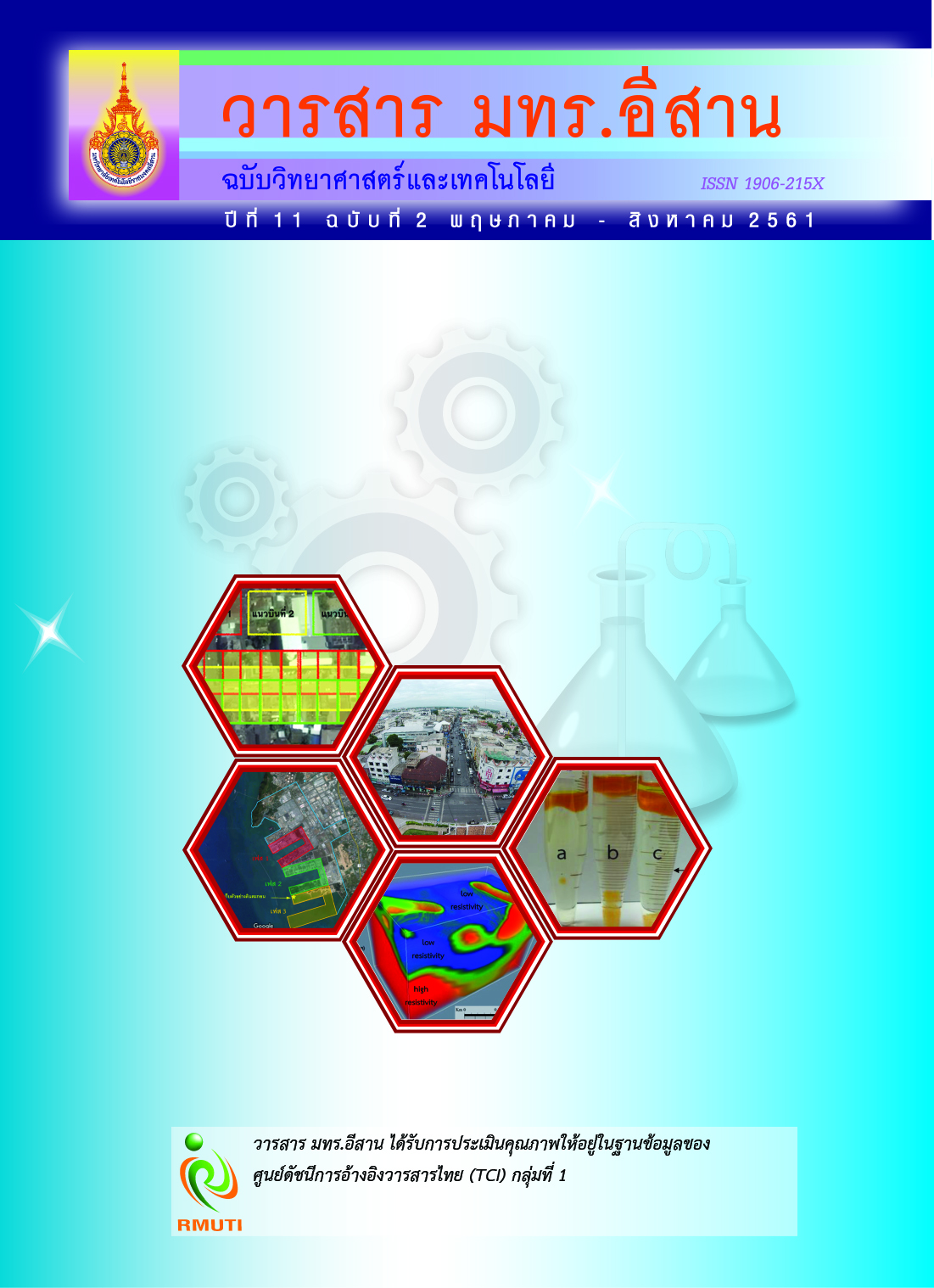Lower Density Solvent-Based Dispersive Liquid-Liquid Microextraction for the Determination of Benzoic Acid
Main Article Content
Abstract
A lower density solvent-based dispersive liquid-liquid microextraction (DLLME) was optimized for the determination of benzoic acid in fruit juices by HPLC-UV method. The type and volume of lower density of extraction and dispersive solvents were investigated. A 0.5 mL octanol was found to be an optimal extraction solvent, and a 2.0 mL acetonitrile was suitable as dispersive solvent. An extraction procedure was applied for extraction of benzoic acid from three orange juice samples, which was purchased from the local market. An optimal HPLC condition was achieved under a mixture condition of methanol and 1 % acetic acid (97 and 3) was found as an optimal mobile phase. The method was validated under the optimized conditions of the extraction and the determination. The good linearity with R2 0.9939 was obtained in the concentration range of 25 - 1000 mg/L. The relative standard deviations (%RSD) of retention time and peak area were acceptable. The LOD was 2.2 mg/L and the recovery was satisfied (104±7 %). The results show that the extraction and the determination were efficient for determining of benzoic acid.
Article Details
References
[2] Zaifa Pan, Lili Wang, Weimin Mo, Chen Wang, Wei Hu, and Juanjuan Zhang (2005). Determination of Benzoic Acid in Soft Drinks by Gas Chromatography with On-Line Pyrolytic Methylation Technique. Analytica Chimica Acta. Vol. 545, Issue 2, pp. 218-223. DOI: 10.1016/j.aca.2005.04.072
[3] Techakriengkrai, I. and Surakarnkul, R. (2007). Analysis of Benzoic Acid and Sorbic Acid in Thai Rice Wines and Distillates by Solid-Phase Sorbent Extraction and High-Performance Liquid Chromatography. Journal of Food Composition and Analysis. Vol. 20, Issues 3-4, pp. 220-225. DOI: 10.1016/j.jfca.2006.10.003
[4] Knoblauch, J. M., Scott, D. K., Smith, L. D., and Garg, U. (2010). Determination of Benzoic Acid in Serum or Plasma by Gas Chromatography-Mass Spectrometry (GC/MS). Methods in molecular biology (Clifton, N.J.). Vol. 603, Number 8, pp. 121-128. DOI: 10.1007/978-1-60761-459-3_11
[5] T. A. Kokya, K. Farhadi, and A. A. Kalhori,. (2012). Optimized Dispersive Liquid-Liquid Microextraction and Determination of Sorbic Acid Benzoic Acid in Beverage Samples by Gas Chromatography. Food Analytical Methods. Vol. 5, Issue 3, pp.351-358. DOI: 0.1007/s12161-011-9245-x.
[6] Ferreira, I. M. P. L. V. O., Mendes, E., Brito, P., and Ferreira, M. A. (2000). Simultaneous Determination of Benzoic and Sorbic Acids in Quince Jam by HPLC. Food Research International. Vol. 33, No. 2, pp.113-117. DOI: 10.1016/S0963-9969(00)00014-4. 24 Lower Density Solvent-Based Dispersive Liquid-Liquid Microextraction for the
Determination of Benzoic Acid
[7] Burana-osot, J., Arunsingkharat, L., Naksuk, M., Naungnamjai, S., and Saetun, T. (2014). Validation of a HPLC Method for the Determination of Benzoic Acid and Sorbic Acid in Noodles. Chiang Mai Journal of Science. Vol. 41, Number 2, pp. 370-382
[8] Mota, F. J. M., Ferreira, I. M. P. L. V., Cunha, S. C., Beatriz, M., and Oliveira, P. P. (2003). Optimisation of Extraction Procedures for Analysis of Benzoic and Sorbic Acids in Food Stuff. Food Chemistry. Vol. 82, pp. 469-473
[9] Khoddami, A., Wilkes, M. A., and Roberts, T. H. (2013). Techniques for Analysis of Plant Phenolic Compounds. Molecules. Vol. 18, pp. 2328-2375. DOI: 10.3390/molecules18022328
[10] S. A.VTfouni, and M. C. F. Toledo. (2002). Determination of Benzoic Acid and Sorbic Acids in Brazilian Food. Food Control. Vol. 13, Issue 2, pp. 117-123. DOI: 10.1016/S0956-7135(01)00084-6
[11] Rezaee, M., Assadi, Y., Milani Hosseini, M. R., Aghaee, E., Ahmadi, F., and Berijani, S. (2006). Determination of Organic Compounds in Water Using Dispersive Liquid-Liquid Microextraction. Journal of Chromatography A. Vol. 1116, Issue 1-2, pp. 1-9. DOI: 10.1016/j.chroma.2006.03.007
[12] Rezaee, M., Yamini, Y., and Faraji, M. (2010). Evolution of Dispersive Liquid-Liquid Microextraction Method. Journal of Chromatography A. Vol. 1217, Issue 16, pp. 2342-2357. DOI: 10.1016/j.chroma.2009.11.088
[13] Abedi, A. S., Mohammadi, A., Azadniya, E., Mortazavian, A. M., and Khaksar, R. (2014). Simultaneous Determination of Sorbic and Benzoic Acids in Milk Products Using Optimized Microextraction Technique Followed by Gas Chromatography. Food Additives & Contaminants: Part A. Vol. 31, Issue 1, pp. 21-28. DOI: 10.1080/19440049.2013.859742
[14] Kokya, T. A., K. Farhadi, and A. Kalhori. (2012). Optimized Dispersive Liquid-Liquid Microextraction and Determination of Sorbic Acid and Benzoic Acid in Beverage Samples by Gas Chromatography. Food Analytical Methods. Vol. 5, Issue 3, pp. 351-358. DOI: 10.1007/s12161-011-9245-x
[15] Hui, Z., Minmin, C., and Xinyu, J. (2010). Determination of Benzoic Acid in Water Samples by Ionic Cold-Induced Aggregation Dispersive LLME Coupling with LC. Chromatographia. Vol. 72, Issue 11-12, pp. 1195-1199. DOI: 10.1365/s10337-010-1791-7
[16] Mohd, M. S., Mokhtar, S. U., Miskam, M. A., and Ibrahim, W. A. W. (2011). Determination of Organophosphorus Pesticides by Dispersive Liquid-Liquid Microextraction Coupled with Gas Chromatography-Electron Capture Detection. The Malaysian Journal of Analytical Sciences. Vol. 15, No. 2, pp. 232-239
[17] Food and Drug Administration. (2014). General Standard for Food Additives: GSFA 2014, Ministry of Public Health, Thailand. Access (1 July 2016). Available (https://www.foodfti.com/Files/Name/CONTENT1066259098564.pdf)


